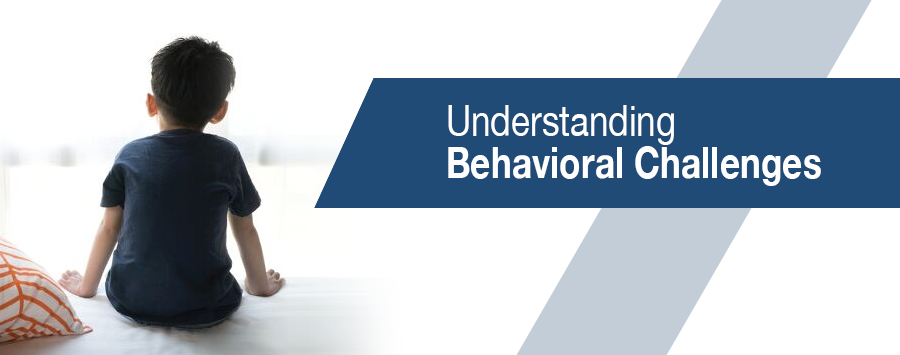Understanding Behavioral Challenges
September 19th, 2019 by Global Down Syndrome Foundation

An important study in the journal of mental health research in intellectual disabilities shows that children with Down syndrome demonstrate increased behavioral issues compared with their typical peers. Early intervention and a development strategy can help.
 This article was published in the award-winning Down Syndrome World™ magazine. Become a member to read all the articles and get future issues delivered to your door!
This article was published in the award-winning Down Syndrome World™ magazine. Become a member to read all the articles and get future issues delivered to your door! A STUDY CONDUCTED by doctors at the Anna and John J. Sie Center for Down Syndrome at Children’s Hospital Colorado, an affiliate of the Global Down S yndrome Foundation, found that 94% of children with Down syndrome experienced one or more behavioral challenges on a w eekly or even daily basis. These behaviors include wandering off, refusal to follow instructions, aggression, impulsivity, and difficulty transitioning from activity to activity. Behavioral challenges can not only impact a child’ s quality of life but also cause major str esses for parents, teachers, and other caregivers.
In the study, Lina Patel, Psy.D., and her three co-authors, Kristine Wolter-Warmerdam, Noel Leifer, and Francis Hickey, M.D., analyzed current tools for measuring behavior in children with Down syndrome to determine which methods were effective and which could be improved upon. They also surveyed parents to learn about which behaviors were the most common and if any challenges shared a common denominator. The doctors published their results in late 2018.
Children with Down syndrome have many positive behavioral traits, and typical children certainly have negative behavioral issues. However, because of lack of research, behavior issues in children with Down syndrome are less understood. Behavioral challenges can hamper a child’s ability to function independently, perform well in school or other social settings, and even handle everyday tasks, such as bathing and dressing, at home. By understanding what can trigger certain behavioral issues, parents and teachers can better develop strategies to intervene before issues progress.
COMMUNICATION TOOLS: A COMMON DENOMINATOR
A variety of factors may fuel undesirable behaviors, according to Dr. Patel, lead author and D irector of Psychology at the Sie Center.
“I feel like motivation is a key factor,” Dr. Patel says. “It doesn’t mean that children with Down syndrome are unmotivated. It might just mean they are motivated by their own interests versus the task at hand, which then may result in behavioral challenges.”
Dr. Patel and her co-authors wanted to know which behaviors parents of children with Down syndrome found most concerning. They asked parents of 274 children seen at the Sie Center from 2010 to 2015 to fill out a specially designed questionnaire. On the questionnaire, parents were asked to state the frequency with which 16 behavior challenges occurred and their level of concern about each. Parents could also name additional behavioral challenges not listed on the form. The study is one of the largest of its kind and the results were not completely anticipated.
Noncompliance, wandering, sitting down and refusing to move, and aggression were the most common difficult behaviors parents reported. The amount and frequency of challenging behaviors was much higher than previously reported in scientific literature, with nearly 100% of parents noting the existence of challenging behaviors at least weekly.
“The most striking result we found was the frequency of behavioral challenges,” Dr. Patel says. “I think we did capture a wider array of behaviors, resulting in a higher percentage of children experiencing those behaviors. The good news is that many of the behavioral challenges that we assessed can be addressed using behavioral strategies that are informed by neurodevelopment.”
Neurodevelopment is the brain’s development of neurological pathways that influence areas including memory, intellectual functioning, attention, and focus.
The researchers also wanted to determine if any of these behavioral challenges shared a common denominator. They found that the inability of a child to effectively communicate his or her wants and needs was associated with many behavioral challenges.
“Behavior is a form of communication people use when they do not have access to other methods of communication, like verbal communication,” Dr. Patel explains. “Therefore, it’s not surprising that individuals with Down syndrome would have more behavioral challenges if they do not have more functional communication strategies.”
TAKE ACTION EARLY
The longer parents allow unwanted behaviors to persist, the more ingrained these behaviors may become.
“Behavioral interventions can make a difference and really change behavior,” says Elise Sannar, M.D., Assistant Professor of Child and Adolescent Psychiatry at Children’s Hospital Colorado. “If [parents] just live with [a behavior], it’s definitely not going to get better. If kids with Down syndrome learn that if they have a tantrum or refuse to move, they’ll get what they want, that will be reinforced, and they’ll continue to engage in that behavior.”
When concerning behaviors arise, parents should notify their child’s pediatrician or primary care physician as soon as possible so medical causes can be ruled out. Many behavior issues can be triggered by medical ailments to which children with Down syndrome are more predisposed. One such medical ailment is obstructive sleep apnea, which is found in up to 70% of children with Down syndrome.
In addition, parents should pay attention to the context of behavioral challenges — when, where, and with whom they occur, and what happens before and after them, says Anna Esbensen, Ph.D., Associate Professor, Research Director at the Jane and Richard Thomas Center for Down Syndrome in the Division of Developmental and Behavioral Pediatrics at Cincinnati Children’s Hospital Medical Center.
These clues can provide important information about why behaviors occur. Parents who are concerned about a behavior that happened when they weren’t around can ask their child’s friends, teacher, or employer for information about what took place.
“Teaching the child a replacement behavior or a different way of achieving or communicating their needs are helpful ways of teaching an adaptive … method of achieving their desired function,” Dr. Esbensen explains.
She continues, “Once we understand the function of the child’s behaviors, there are evidence-based strategies that can be used to modify that behavioral challenge.”
According to Dr. Sannar, one such strategy is applied behavior analysis (ABA), which uses a variety of techniques, such as positive reinforcement, to increase helpful behaviors and decrease damaging ones. ABA can be effective in children with Down syndrome, autism, and other conditions associated with behavioral challenges.
For example, Dr. Patel says, ABA can be used to stop a child with Down syndrome from running or wandering away from caregivers, also called elopement. A behavioral analyst can collect data to better understand why the child is eloping — is he or she bored, trying to avoid a difficult task that is hard, or eager for attention? Once the analyst has an answer, he or she can create a plan to address it. For example, if the child is avoiding work that feels too hard, the analyst can slowly increase a task’s difficulty or teach the child to ask for a break.
Helping people with Down syndrome manage behaviors is important, not only for their success in school and social situations but also as they enter adulthood, says Dr. Patel.
“Many individuals with Down syndrome who have the skill to seek employment may not be able to if they have behaviors that interfere with their job,” she advises. “It may be more difficult to gain independence with things like staying home alone or even living with others if these behaviors are not addressed.”
While it is more difficult to change longingrained behaviors, therapies and strategies exist that help adults, and studies are starting to address this older population.
The researchers plan to develop a more comprehensive tool to capture the full range of behavioral health challenges that children
with Down syndrome experience. They hope such a tool would help pediatricians and other community providers determine when to refer children to a behavioral health specialist. Most importantly, by understanding and analyzing. these behaviors, they hope to empower both individuals with Down syndrome and their parents to take necessary actions to improve and maintain appropriate behaviors.
Like this article? Join Global Down Syndrome Foundation’s Membership program today to receive 4 issues of the quarterly award-winning publication, plus access to 4 seasonal educational Webinar Series, and eligibility to apply for Global’s Employment and Educational Grants.
Register today at downsyndromeworld.org!

 Experience our inspirational and groundbreaking videos and photos. Our children and self-advocates are beautiful AND brilliant!
Experience our inspirational and groundbreaking videos and photos. Our children and self-advocates are beautiful AND brilliant! Make sure your local Representatives are on the Congressional Down Syndrome Task Force.
Make sure your local Representatives are on the Congressional Down Syndrome Task Force.